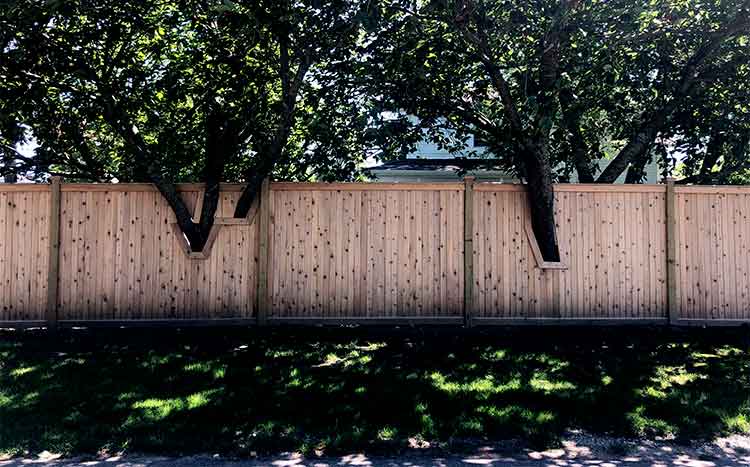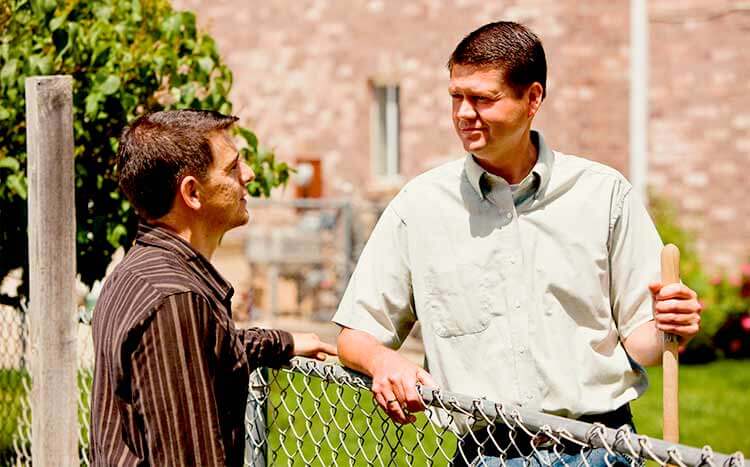By law, your ownership not only encompasses the land and any buildings attached to it, such as your home and fence, but it also includes a certain amount of the space above the ground.
You are within your rights to trim a neighbor’s tree that overhangs your property as long as local tree laws and permits allow it. Trees of certain heights are protected and first need a permit from the city before you can trim them.
In most states, it is up to your neighbor to dispose of the tree over your property but to keep things civil, I suggest you dispose of it yourself.
What we cover
ToggleWhen you can & cannot trim a neighbor’s tree
Majority of tree laws1 across the United States allow you to trim the parts of your neighbor’s tree, e.g., the branches, limbs, and roots that extend past the property line into your yard. Tree codes clearly state the circumstances where you are legally allowed to trim your neighbor’s property and when you can’t.
When I am allowed to trim my neighbor’s tree
- In situations where overhanging branches of my next-door neighbor’s tree are constituting a nuisance2 capable of preventing me from enjoying my property.
- If the tree is in a dangerous condition.
When I am not allowed to trim my neighbor’s tree
- You can not trim your neighbor’s tree if local tree ordinances do not permit trimming overhanging branches of a tree not on your property.
- In cases where the tree does not constitute a nuisance to you, it is not infringing, and it doesn’t pose a safety hazard.
- You cannot trim a tree to prevent it from crossing the property line.
- You cannot trim your neighbor’s tree simply because it is blocking your view.
What if you trim a neighbor’s tree without asking?or’s tree
Most states allow you to legally trim your neighbor’s tree without his consent under the following conditions.
- If the tree is encroaching into your property in a way that constitutes a nuisance.
- You (or anyone you hire to trim the tree) must not enter your neighbor’s property to trim a tree, even when the branches of that particular tree intrude into your property.
- You are required to trim the tree with reasonable care so as not to ‘willfully, maliciously or wantonly cut, destroy or injure the tree3.’ If you harm or destroy your neighbor’s tree, you could pay the tree owner three times the value of the tree.
You are expected to perform these tasks with a complete understanding of your legal responsibilities. Massachusetts tree codes impose an additional fine or possible jail time if you violate any of these provisions.

What to do if a neighbor’s tree is affecting you?
You have several informal and legal options available if your neighbor’s tree directly constitutes a nuisance, and it is preventing you from making good use of or enjoying your property.
They include:
- Talk to your neighbor: you can take an informal approach and approach your neighbor directly to solve the tree problem that is acceptable to both parties.
- Involve the authorities: if your neighbor is non-committal about resolving the issue, you can file a hazard complaint with the local authorities. Municipality officials can issue your neighbor a notice of removal or remove it themselves if the tree is determined to be in a dangerous condition.
- Call your utility company: you can get your utility company to remove your neighbor’s tree if it threatens utility lines coming into your house or within the neighborhood.
- Trim the tree: you have the right to trim or cut your neighbor’s tree branches, limbs, or part of its roots that is inside your yard right up to the property line.
Whose responsibility is it to cut overhanging branches?
It is your responsibility to cut or bear the costs of trimming the overhanging branches of your neighbor’s tree. As a property owner, you must trim the parts of your neighbor’s tree that extend into your yard up to the property line. You can’t go any further, and you can’t make your neighbor pay for the trimming costs. Your neighbor has no liability if one of the overhanging branches breaks and falls on your property, damaging it in the process.
What if my neighbor’s tree is too tall?
File a nuisance claim if the tree is impeding your view or shedding leaves or branches on your property, although your odds of success are slim. You have a better chance if the tree is unstable, diseased, or in danger of being toppled during high winds. Suppose you can convince a judge that the tree is in a dangerous condition and, hence, a hazard to lives and property. A notice of removal will be issued to your neighbor.
What if overhanging branches from my neighbor’s tree caused damage to my property?
Tree laws swing both ways regarding liability for damage caused by overhanging trees on a neighbor’s property. For example, Florida tree law states, a landowner may not be responsible for damage caused by the overhanging branches of a healthy tree to an adjoining property. But the landowner is liable for damages caused to the adjacent property if the tree branches are dead’.
In a nutshell:
- Your neighbor has no liability if the overhanging branches of his otherwise healthy tree fall on and damage your property.
- You can legally trim – at your expense (in several states) the overhanging branches of your neighbor’s tree on your property. But only up to the property line.
- Yes, your neighbor is responsible for damages caused by the dead/diseased overhanging branches of his dead/ diseases/ unstable tree if it falls on and damages your property.
Will my homeowner’s insurance pay for the damage?
Homeowners’ insurance4 usually covers the repair and tree cleanup costs (up to the property line). It is essential to file a claim with your insurer immediately whenever an incident occurs to ensure quick payment of your claim. The insurance company will go after your neighbor (if he is liable) for damages afterward.




Settling disputes about trees with neighbors
Trees mean a lot to some people. So, it is vital to approach all disputes concerning trees with respect for your neighbor’s feelings. Here are a few tips.
- Approaching your neighbor with your concerns will resolve the problem much faster than filing a complaint.
- Do not touch your neighbor’s tree unless you have a legal reason for doing so.
- It is a good idea to hire a certified arborist to assess the tree.
Document your correspondence and hire a tree lawyer if you receive a hostile or adverse reaction from your neighbor. - Sue your neighbor if all mediation fails.

How do I ask my neighbor to remove his tree?
If you have a valid reason for why your neighbor’s tree has to go, walk up to your neighbor and calmly discuss your feelings. And by a good reason, I mean if the tree in question is:
- Unstable and poses a grave danger to your life, your property, and the neighborhood.
If your neighbor disputes your view, you may hire a certified arborist to assess the tree’s condition. Share the results with your neighbor, and explain the potential hazard to both of your properties. Hopefully, your neighbor should see reason, and both of you can work things out.

How can I force my neighbor to remove his tree?
If your neighbor does not consent to cut down his tree, then you need to prove before a judge that the tree is dangerous and a threat to your safety. In California, it is called “action for abatement.” If your argument is convincing, the judge can force your neighbor to remove his tree.
- Robert Rafii, Esq. (2023) Conflicts Involving Trees and Neighbors. <https://www.findlaw.com/realestate/neighbors/conflicts-involving-trees-and-neighbors.html> Accessed: 05-03-2024.
- California Legislative Information, (2019) California Law >> Code Section. <https://leginfo.legislature.ca.gov/faces/codes_displaySection.xhtml?sectionNum=3346.&lawCode=CIV> Accessed: 05-03-2024
- Massachusetts Legislature, (2019) Section 11: Injury to trees of another person. <https://malegislature.gov/Laws/GeneralLaws/PartI/TitleXIV/Chapter87/Section11> Accessed: 05-03-2024
- Insurance Information Institute, (2019) If a tree falls on your house, are you covered? <https://www.iii.org/article/if-a-tree-falls-on-your-house-are-you-covered> Accessed: 05-03-2024










